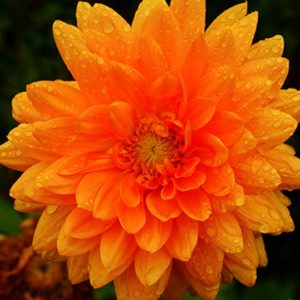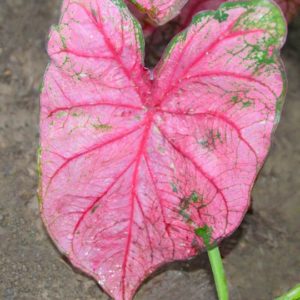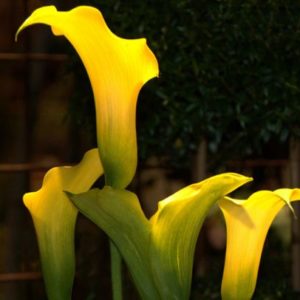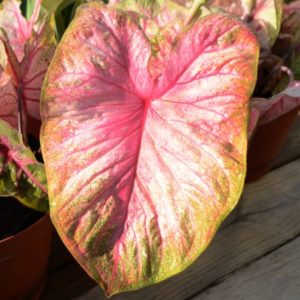Description
 Mammoth Elephant Ear, Colocasia Esculenta
Mammoth Elephant Ear, Colocasia Esculenta
STRONGLY DEER RESISTANT AND REPELLENT
Elephant Ears are ancient plants that until the 19th century were primarily valued as a starchy food source. In many tropical areas where potatoes, rice and other starch sources could not be grown, elephant ears served as an important nutritional source. During the Victorian Era, when the middle classes of Europe, the British Isles and the United States began to have some free time and disposable income, they took up leisure travel. During their journeys, they discovered many exotic plants and one of them was the elephant ear. They brought these elephant ears back to their homes and made them specimen plants in their newly erected conservatories. As a result, elephant ears exploded in popularity.
Elephant Ears are indigenous to the tropical regions throughout Asia. However there are two areas where most of the elephant ears that we have today came from: the tropical foothills of the Himalayas and Malaysia.
One of the amazing facts about these amazing plants is that their “bulbs” are not true bulbs. They are actually rhizomatous roots. As with all rhizomatous root plants, they spread horizontally through expansion of their root system by “bulbing” or creating new tubers. Only a few of the elephant ears produce the “round” or “egg-shaped” roots that we associate with elephant ears. Most elephant ears produce a small cluster of stringy, hairy tuberous roots. Often the first leaves produced by elephant ears like White Lava, Hawaiian Punch, Mojito and Hilo Beauty do not have the distinctive coloring that you see in photos of these cultivars. Once the elephant ear is established and producing more mature leaves the distinctive coloring/variegation develops.
The most important amazing fact about these plants is that Elephant Ears are Deer Resistant AND Appear to be Deer Repellent.
Elephant Ears contain in their leaves and stems two chemical compounds, Oxalic Acid and Asparagine, that are mildly toxic, meaning they can cause abdominal pain, cramping and severe diarrhea. Deer definitely do not eat elephant ears, but, additionally, it has been reported by many, many of our customers that when they plant elephant ears in a frequently trafficked deer area, the deer seem to change their path to avoid the elephant ears. This seems to be particularly true for Colocasia esculenta.
Elephant Ears come in a variety of leaf shapes, leaf sizes, textures, habits and colors. There are two species of elephant ears: colocasias and alocasias. In general, colocasias are very large plants reaching heights of 8-10+ feet and spreads of 4-6+ feet. They come in several colors, but mostly their leaves are varying shades of green.
Alocasias, also known as Upright Elephant Ears, usually produce large leaves, 1-2 feet wide by 2-3 feet long with subtle to strong ruffling around the edge of each leaf. The best known alocasia leaves are always upright with the tip of the leaf pointing skyward. The plants can reach heights of 10-12+ feet with narrow spreads of 2-4 feet. There are also alocasias that are much smaller plants, rarely reaching heights of 30-36 inches, but with some of the most exotic looking leaves on earth.
Mammoth Elephant Ears are colocasias and are the largest “bulbs” that Harvesting History Heirlooms offers. They are actually tuberous roots, not true bulbs. They are also an important food source for many tropical societies. The starchy substance they produce is known as poi. Colocasia esculenta bulbs are sold in four sizes: medium, large, extra large and mammoth. Harvesting History Heirlooms only sells mammoth-sized bulbs.
The plants produce elegantly arched stems with huge uniformly colored green leaves 18-30 inches long. They make stunning specimen plants for the home, the deck or patio or the yard. Mammoths can reach heights of 5-6 feet with horizontal spreads of 4-6 feet.
Today these extraordinary plants are popular in the tropical and subtropical regions of the planet. Their popularity is growing in the temperate regions as homeowners and container gardeners learn how easy it is to grow elephant ears.
Planting Elephant Ears
Elephant Ears are some of the easiest plants to grow. They are an excellent choice for someone who is just getting into gardening because they are not very demanding, but they produce absolutely spectacular results – some of the largest plants you can grow in your garden, on your deck/patio or in your home. Because of their spectacular size, they are a great way to inspire children to be interested in gardening.
Unless you live in Hardiness Zones 8-11 where you do not need to lift your elephant ears in the fall, we strongly recommend that you plant your elephant ears in containers. If you plant your elephant ears in Hardiness Zones 8-11 directly into the ground, add some organic matter like peat moss and/or compost to the soil when you plant the bulb.
Most bulbs clearly have a bull’s eye at one end. The bull’s eye is the top of the bulb as you can see from the following photos. Bury the bulb so that the top is covered by 4-6 inches of soil.
There are some schools of thought that suggest you do not need to cover the top of the bulb. We heartily disagree. These bulbs produce huge amounts of heavy top growth. The top growth is very vulnerable to breezes and winds. As the winds blow the top growth, the bulb is shaken and the roots are compromised and may break loose from the bulb. If the top of the bulb is exposed the winds can wreak havoc on the bulb and its roots.
The bulbs should be planted at least 3-4 feet apart in areas where they will receive partial or full shade. In Hardiness Zones 1-5, the elephant ears can tolerate full sun.
Water thoroughly and keep the soil very moist. It can take 4-6 weeks before some elephant ears sprout, so we advise starting the bulbs in temporary pots before taking them outside. The temporary pots need only be large enough to hold the bulbs.
Elephant ears need very little care, but if you want to fertilize, use a high nitrogen-high phosphorus fertilizer (10-10-5) no more frequently than once a month.
In the fall, if your area experiences frost, then you must lift your bulbs. When the evening temperatures start to dip routinely into the low 50s, choose a dry day and dig up the bulbs. Leave them for several days to thoroughly dry out and then place them in a container like a wooden crate or on a shelf in a cool, dark place. DO NOT store them in newspaper or sawdust or wood shavings or Styrofoam peanuts. The one thing that destroys elephant ear bulbs is mold and all of these media can have mold spores.
Planting Elephant Ears In Containers
We believe that elephant ears should be planted in pots. The size of the container that the bulb is planted in dictates the size of the plant that eventually grows from the bulb. The pot must be deep, a minimum of 10-12 inches in diameter.
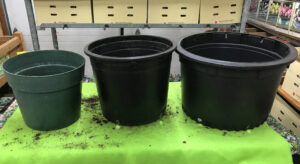
| Containers for Elephant Ears | ||
| Left – Smallest Container 10-12 inches |
Center – Ideal Container 14 inches |
Right – Best Container 18 inches |
Never use specialty soil mixes for these containers. These soil mixes are too light and allow the bulbs to move too much thus compromising the roots. The best soil mix is 60% top soil, 20% peat moss and 20% dehydrated cow manure or compost.
Check Out Our YouTube Video On The Soil Mix For Containers
To plant the bulb, line the bottom of the container with 3 inches of soil and then bury the entire bulb with soil, making sure the top of the bulb is covered with 4-6 inches of soil. Water thoroughly and continue to keep the soil moist. It will take 4-6 weeks for the bulb to sprout. Feed the elephant ear once a month with a high nitrogen-high phosphorus fertilizer like 10-10-5.
In the fall, you can bring the entire pot inside and treat the plant as a houseplant or you can cut all the top growth back and bring the pot into a cool dark area. If you must remove the bulb from its pot, do so following the directions described in the previous section.
About every three years, whether your elephant ear is in the ground or in a pot, it needs to be dug up and the baby elephant ears need to be removed from the original bulb and planted elsewhere.
Harvesting History Heirlooms has several YouTube videos on Elephant Ears. They can be found at the following links:
GROWING ELEPHANT EARS IN CONTAINERS
ELEPHANT EARS – THEIR BACKGROUND AND HISTORY
5 GREAT ELEPHANT EARS
THE PERFECT SOIL MIX FOR CONTAINERS
ELEPHANT EARS – HOW THE LEAVES CHANGE AS THE PLANTS MATURE


